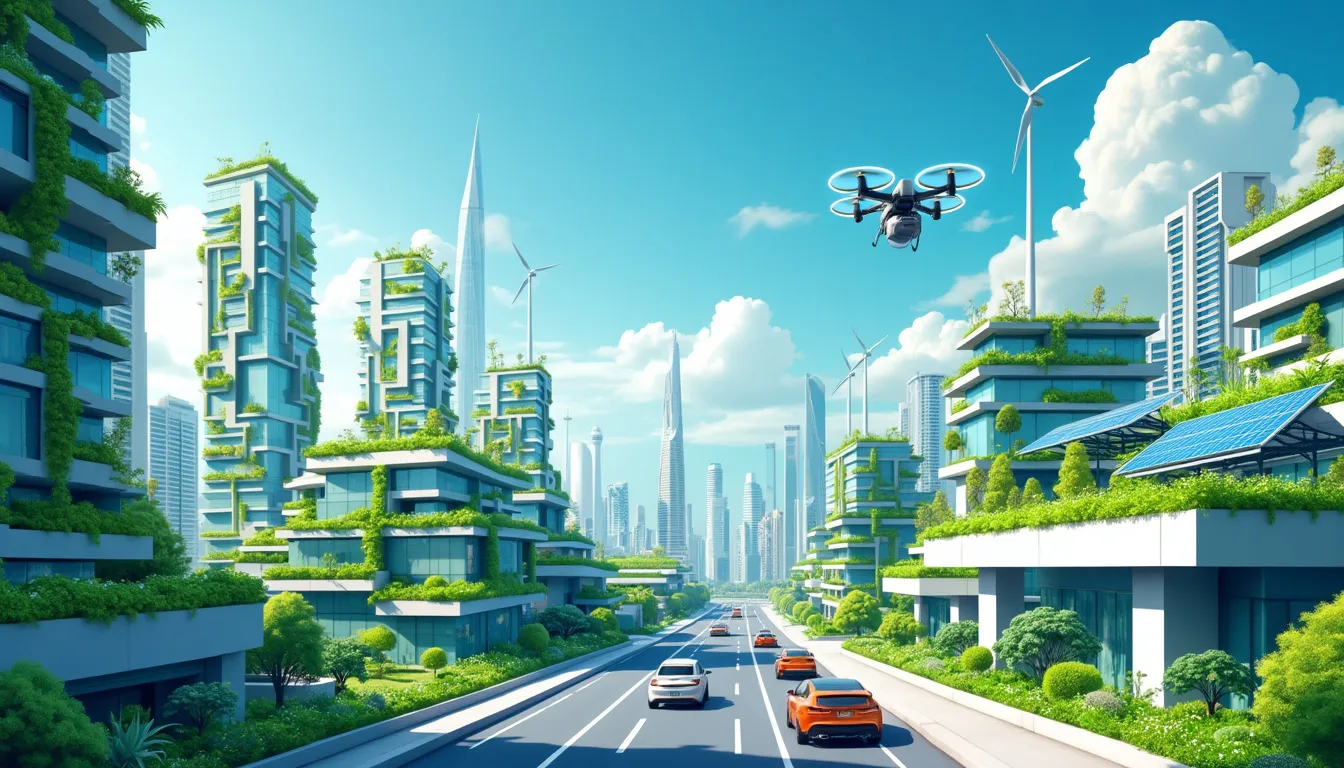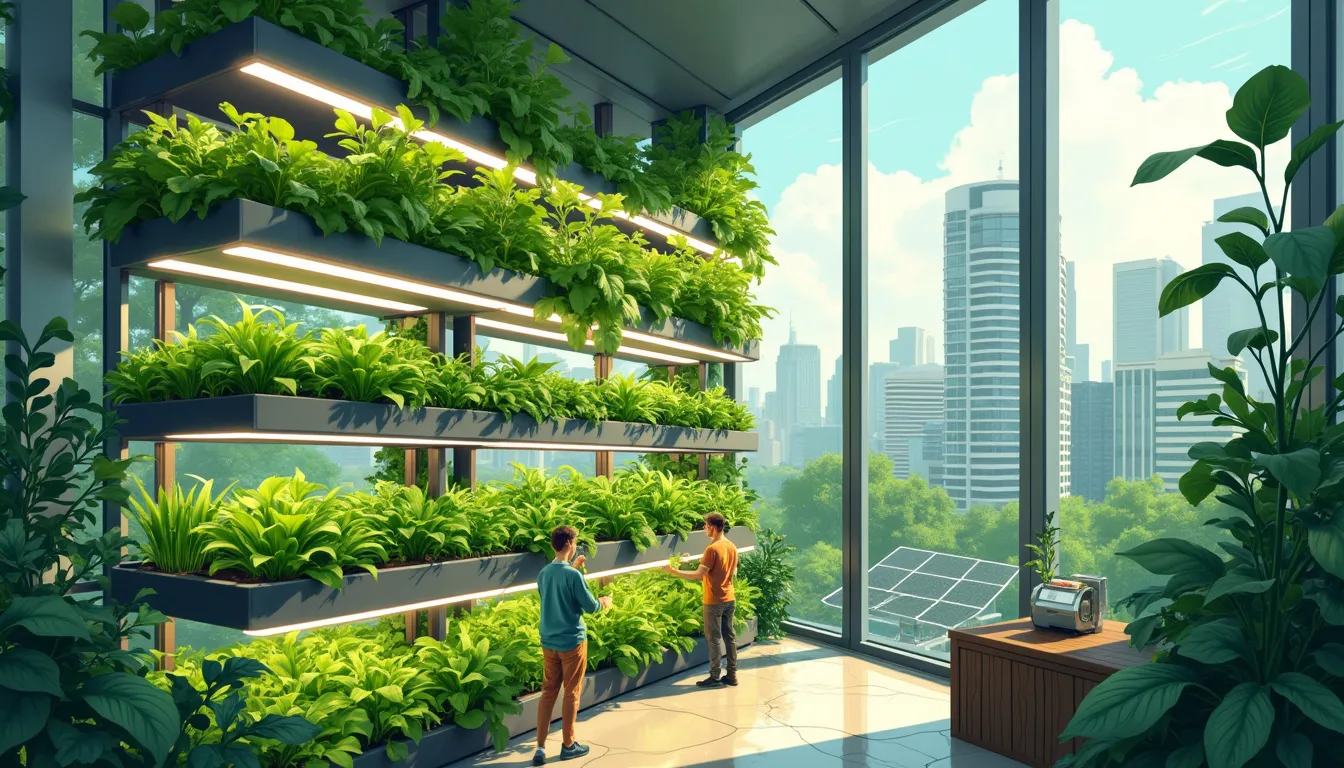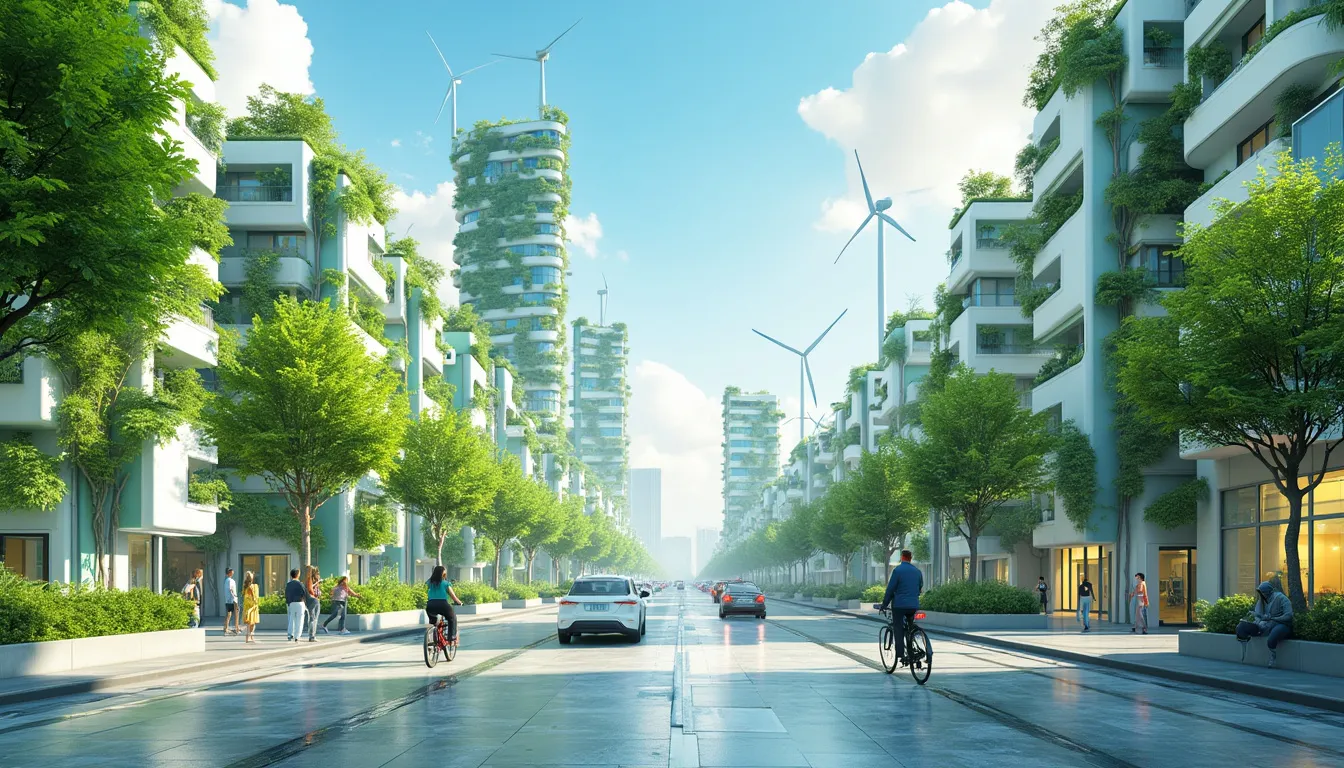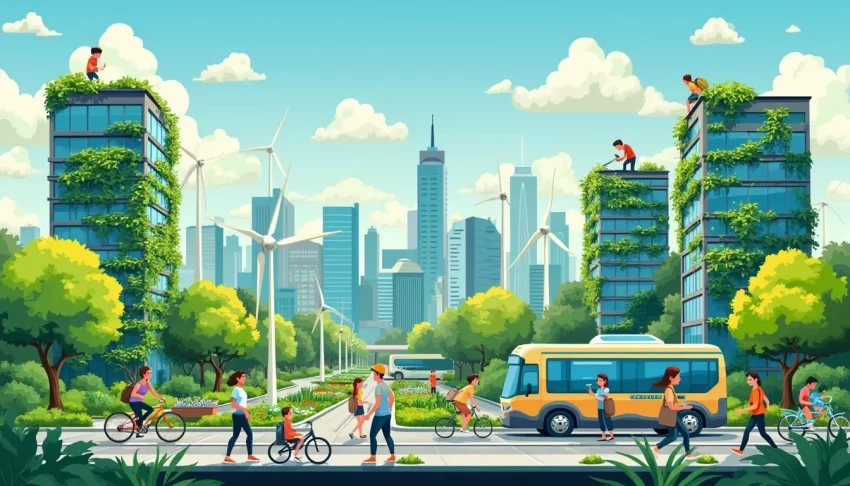Sustainable solutions are no longer a distant aspiration but a critical necessity in our global efforts to combat climate change and secure a greener future. As we grapple with climate crises, pollution, and resource depletion, the call for innovative, sustainable practices has never been louder. The importance of integrating these solutions into our daily lives and businesses cannot be overstated. Not only do they pave the way for a healthier planet, but they also foster economic resilience and social well-being.
The journey of sustainable practices has seen remarkable evolution. From the rudimentary conservation efforts of the past to today’s sophisticated eco-technologies, our approach to sustainability has grown by leaps and bounds. Early initiatives, often grassroots movements or small-scale projects, laid the groundwork for the expansive, tech-driven strategies we see today. These advancements reflect an increasing global demand for solutions that are not only environmentally sound but also innovative and forward-thinking.
This rising demand underscores the urgency of the situation. Climate reports and environmental studies consistently highlight the crucial window we have to mitigate severe ecological damage. The call to action is clear: we must leverage technological innovations, adopt eco-friendly practices, and embrace robust policies to forge a greener future. This article delves into the groundbreaking technological advancements and sustainable practices shaping our world, the supportive policies fostering these changes, and the future prospects and challenges we face on this journey. By exploring these facets, we aim to inspire and empower individuals and businesses to integrate sustainable solutions into their everyday operations, contributing to a collective effort toward a sustainable planet.
Introduction to Sustainable Solutions
The significance of sustainable solutions in the fight against climate change can hardly be overstated. As our planet grapples with escalating environmental challenges, the urgency to adopt and innovate sustainable practices intensifies. From mitigating the impacts of global warming to conserving finite natural resources, these solutions are pivotal in steering us towards a greener future.
Overview of the Importance of Sustainable Solutions in Combating Climate Change
Climate change, driven predominantly by human activities, poses one of the most existential threats to our world. Rising global temperatures, more frequent and severe weather events, and the loss of biodiversity underscore the need for immediate action. Sustainable solutions—ranging from renewable energy sources to sustainable agriculture—are instrumental in addressing these challenges.
By reducing greenhouse gas emissions, minimizing waste, and promoting resource efficiency, sustainable practices help stabilize the climate and safeguard ecosystems. This fosters not just environmental health but also economic stability and social well-being. For instance, the transition to renewable energy not only cuts down emissions but also creates green jobs, thus promoting economic growth.
Brief History and Evolution of Sustainable Practices
The concept of sustainability is not entirely new. Indigenous communities worldwide have practiced forms of sustainability for centuries, often living in harmony with nature and utilizing resources in a way that ensures their availability for future generations. However, the modern sustainability movement gained momentum in the latter half of the 20th century.
In 1962, Rachel Carson’s seminal book Silent Spring spotlighted the adverse effects of pesticides, sparking widespread environmental awareness. The 1970s saw the establishment of Earth Day and the founding of various environmental organizations. The United Nations took decisive action in 1987 with the Brundtland Report, which popularized the term sustainable development, defined as development that meets the needs of the present without compromising the ability of future generations to meet their own needs.
Since then, the drive towards sustainability has evolved, encompassing diverse sectors such as energy, agriculture, transportation, and construction. Innovations have accelerated in recent decades, supported by advances in technology, increased environmental awareness, and stronger regulatory frameworks.
Increasing Global Demand for Innovative Sustainable Solutions to Ensure a Greener Future
The growing global demand for innovative sustainable solutions is evident in various facets of society. Governments, businesses, and individuals alike are recognizing the necessity of sustainable practices and investing in technologies and systems that promise to reduce environmental footprints.
For instance, the renewable energy sector has seen exponential growth. According to the International Renewable Energy Agency (IRENA), global renewable energy capacity increased by over 260 gigawatts in 2020 alone. Solar photovoltaics and wind power lead this surge, underscoring the shift from fossil fuels to cleaner energy sources.
Moreover, consumer preferences are rapidly changing. There is a burgeoning market for sustainable products, with individuals increasingly opting for eco-friendly goods and services. A 2021 survey by IBM and the National Retail Federation revealed that nearly 70% of consumers in the U.S. and Canada consider sustainability when making purchasing decisions.
Businesses, too, are responding to this shift. Corporations are integrating sustainability into their core strategies, recognizing that eco-friendly practices can drive innovation, enhance brand reputation, and ensure long-term profitability. Initiatives such as the Science Based Targets initiative (SBTi) are guiding companies in setting emissions reduction targets in line with the latest climate science.
Even educational institutions are adapting, with an emphasis on sustainability in curriculums and research. Universities are playing a critical role in driving innovation and preparing the next generation of leaders to handle environmental challenges effectively.
In summary, the importance of sustainable solutions in mitigating climate change cannot be overstated. As we look back at the evolution of sustainable practices and recognize the escalating global demand for innovative solutions, it becomes clear that sustainability is no longer just an option. It is an imperative for ensuring a healthier, more resilient planet for future generations.

Technological Innovations in Sustainable Solutions
In the quest for a greener future, technology has emerged as a vital ally, driving the development of innovative sustainable solutions that tackle some of the most pressing environmental challenges. These advancements span across various sectors, significantly contributing to the reduction of carbon footprints and the promotion of sustainability. Let’s delve into some of the groundbreaking technologies reshaping our world.
Renewable Energy Technologies: Solar, Wind, and Hydro Advancements
Renewable energy is the cornerstone of sustainable solutions. Solar, wind, and hydro power have seen incredible technological advancements over the past decade, making them more efficient and accessible.
Solar power: Once considered a niche technology, solar power has become one of the fastest-growing sources of renewable energy. Innovations like advanced photovoltaic cells (PV) have significantly increased the efficiency of converting sunlight into electricity. For instance, perovskite solar cells are now reaching efficiency levels above 25% and can be manufactured more cheaply and flexibly than traditional silicon-based panels. Additionally, solar power systems are being integrated into building materials, such as solar roof tiles, effectively turning homes and businesses into power generators.
Wind power: Wind energy has also benefited from technological improvements. Modern wind turbines, which are now capable of generating power even at low wind speeds, have larger rotors and more efficient gearless designs. Innovations such as floating wind farms are now allowing us to tap into ocean wind resources, which were previously inaccessible. These offshore turbines capture winds that are steadier and stronger, providing a more reliable energy source. For example, projects like the Hywind Scotland floating wind farm demonstrate the potential of these advancements.
Hydro power: Hydro power has long been a reliable source of renewable energy. Innovations in small-scale hydroelectric systems, like micro-hydro and run-of-river systems, are making it possible to harness the power of water without the environmental impact of large dams. These systems are particularly beneficial for remote and rural communities. Furthermore, companies are exploring new forms of hydro power generation, such as underwater turbines that capture energy from ocean currents, adding to the versatility of this green energy source.
The Role of Smart Grids and Energy Storage Systems in Optimizing Sustainable Energy
While renewable energy sources are critical, their intermittent nature requires advanced infrastructure to manage and distribute this power efficiently. Enter smart grids and energy storage systems, which are revolutionizing how we handle sustainable energy.
Smart grids: Traditional power grids are being upgraded to smart grids, which utilize digital technology to monitor and manage the flow of electricity from various sources. Smart grids enhance the reliability and efficiency of energy distribution by predicting energy demand and adjusting the flow of electricity accordingly. For instance, they can detect power outages in real-time and reroute power to minimize disruptions. Additionally, smart meters enable consumers to monitor their energy usage, helping to promote energy-saving behaviors. This technology not only supports the integration of renewable energy but also helps reduce energy waste.
Energy storage systems: The development of advanced energy storage solutions like lithium-ion batteries, flow batteries, and soon, solid-state batteries, is fundamental for storing excess energy generated by renewable sources. These storage systems ensure that energy is available even when the sun isn’t shining or the wind isn’t blowing. Innovations like Tesla’s Powerwall and large-scale battery farms are leading the way, providing reliable backup power and enabling a more resilient grid. Energy storage systems also allow for the better match of supply and demand, ensuring a steady energy supply and the optimization of renewable energy use.
Innovations in Sustainable Transportation: Electric Vehicles, Hydrogen Fuel Cells, and Public Transport Transformation
The transportation sector is another significant contributor to greenhouse gas emissions, but technological innovations are paving the way for cleaner alternatives.
Electric vehicles (EVs): The rise of electric vehicles is one of the most visible advancements in sustainable transportation. Electric cars, buses, and even trucks are becoming more common as battery technology improves. Companies like Tesla, Nissan, and Chevrolet are constantly pushing the envelope, increasing the range, reducing the cost, and enhancing the performance of EVs. Charging infrastructure is also expanding, with fast-charging stations that can recharge a vehicle in just minutes. According to a report by the International Energy Agency, the global EV fleet surpassed 10 million in 2022, highlighting the growing acceptance and potential of this technology.
Hydrogen fuel cells: Another promising innovation is the use of hydrogen fuel cells. These cells generate electricity by combining hydrogen with oxygen, producing only water and heat as by-products. This technology is particularly suited for heavy-duty vehicles like trucks, buses, and even trains. Companies like Toyota and Hyundai are investing heavily in hydrogen fuel cell vehicles, and pilot projects are demonstrating their potential for decarbonizing transportation. For example, the Hydrogen Europe initiative is working on creating a robust infrastructure for hydrogen fuel across the continent.
Public transport transformation: Enhancing public transportation systems is also crucial for sustainable urban development. Electrifying buses and trains, upgrading infrastructure, and implementing intelligent transit systems can reduce the environmental impact of public transport. Cities like Copenhagen and Amsterdam are leading by example, investing in extensive bike-sharing programs, electric buses, and efficient metro systems. These transformations encourage more people to opt for public transport, reducing the number of private vehicles on the road and, consequently, lowering emissions.
Embracing these technological innovations is a critical step towards achieving a sustainable future. By leveraging advancements in renewable energy, smart grids, energy storage, and sustainable transportation, we can significantly reduce our environmental footprint and move closer to a greener, more resilient world.

Eco-friendly Practices and Policies
Sustainable Agriculture: Organic Farming, Vertical Farming, and Agroforestry’s Role
Sustainable agriculture stands at the forefront of eco-friendly practices, offering an array of innovative solutions tailored to reduce environmental impact while bolstering food security. Organic farming, for instance, eschews synthetic chemicals in favor of natural methods to enhance soil fertility and control pests. By prioritizing crop rotation, green manure, compost, and biological pest control, organic farming significantly diminishes soil degradation, water contamination, and biodiversity loss. According to the Rodale Institute, transitioning to widespread organic farming has the potential to sequester over 100% of current CO2 emissions.
Vertical farming redefines urban agriculture by cultivating crops in stacked layers. Utilizing controlled-environment agriculture (CEA) technology, vertical farms optimize space and resources, drastically reducing the need for land and water. This method enables year-round production with a fraction of the environmental footprint. Consider AeroFarms in New Jersey, which claims to use 95% less water than traditional farming while delivering yields 390 times greater per square foot.
Agroforestry integrates trees and shrubs into agricultural landscapes, creating symbiotic relationships that enhance ecosystem biodiversity and resilience. Combining forestry and agriculture bolsters soil fertility, improves water retention, and provides habitat for wildlife. The World Agroforestry Centre highlights that agroforestry can also play a crucial role in climate mitigation, with potential to sequester up to 9.28 gigatons of carbon annually.
Waste Reduction Techniques: Recycling, Composting, and Zero-Waste Lifestyle Initiatives
Waste management is a pivotal aspect of sustainable solutions, aiming to minimize the environmental burden of waste. Recycling is the cornerstone of waste reduction, transforming discarded materials into new products. According to the Environmental Protection Agency (EPA), recycling provides significant benefits: it conserves energy, reduces greenhouse gas emissions, and curbs the need for raw materials. For example, recycling one ton of paper can save 17 trees and 7,000 gallons of water.
Composting, another essential technique, turns organic waste into nutrient-rich soil amendments. By diverting food scraps, yard waste, and other organic materials from landfills, composting mitigates methane emissions—a potent greenhouse gas. The U.S. Composting Council reports that composting can reduce 4-5% of national greenhouse gas emissions, showcasing its integral role in climate action.
Adopting a zero-waste lifestyle goes beyond traditional recycling and composting. Zero-waste initiatives advocate for a circular economy where products are reused, repaired, and repurposed. The zero-waste movement aims to send no trash to landfills or incinerators, reducing the environmental impact of consumption. Daniels Roof, a prominent zero-waste advocate, emphasizes that individuals and businesses can make great strides by opting for reusable products, reducing single-use plastics, and supporting companies with sustainable practices.
Governmental and International Policies Supporting Sustainable Solutions and Green Legislation
Policymaking is an indispensable driver of sustainable solutions. Governments and international bodies play a critical role in fostering environmental stewardship through regulations, incentives, and frameworks. The Paris Agreement, for example, is a landmark accord signed by nearly 200 countries, aiming to limit global warming to well below 2°C. This international treaty underscores the collective responsibility to mitigate climate change and accelerate the transition to renewable energy.
On a national level, policies like the U.S. Clean Air Act have yielded significant improvements in air quality and public health by regulating emissions of hazardous pollutants. Similarly, the European Union’s Green Deal sets ambitious targets to achieve climate neutrality by 2050, incorporating initiatives across energy, agriculture, and waste management to promote sustainability.
Incentives such as tax credits, grants, and subsidies further encourage businesses and individuals to adopt eco-friendly practices. For example, the Investment Tax Credit (ITC) in the United States offers a substantial financial incentive for installing renewable energy systems. By alleviating upfront costs, such policies accelerate the adoption of sustainable solutions.
In addition to national policies, local governments implement grassroots initiatives that drive community engagement in sustainability. Programs like San Francisco’s Zero Waste initiative—which aims to divert 100% of waste from landfills by 2030—demonstrate the power of municipal actions in fostering a culture of sustainability. Combating climate change at every governmental level ensures a comprehensive and cohesive approach to environmental preservation.
As we navigate the pathways toward a greener future, adopting and supporting these eco-friendly practices and policies is crucial. Sustainable agriculture, effective waste reduction strategies, and robust legislative frameworks collectively pave the way for innovative sustainable solutions. Each step, be it on an individual or regulatory level, brings us closer to a resilient and sustainable planet.

Future Prospects and Challenges of Sustainable Solutions
Upcoming Trends in Sustainable Solutions
As we look towards the future, numerous exciting trends in sustainable solutions are emerging. These innovations promise to revolutionize the way we approach sustainability and address environmental challenges.
Bioengineering is one such field that holds immense potential. Scientists are developing genetically modified plants that can absorb more carbon dioxide and thrive on less water. This could prove pivotal in offsetting greenhouse gas emissions and combating climate change. An example of this is the recent development of algae biofuel, a renewable energy source that is cleaner and more efficient than fossil fuels.
Carbon Capture and Storage (CCS) is another groundbreaking technology gaining traction. CCS involves capturing carbon dioxide emissions from industrial sources and storing them underground to prevent them from entering the atmosphere. A notable project in this realm is Norway’s Sleipner project, which has successfully stored nearly 20 million metric tons of CO2 since 1996. Such technologies are crucial for decarbonizing industries and achieving net-zero emissions.
Green Building Technologies are also on the rise, promoting energy efficiency and sustainability in construction. Innovations like green roofs, which involve growing vegetation on rooftops, not only improve insulation but also reduce urban heat islands and support biodiversity. Similarly, passive solar design, which strategically positions buildings to maximize natural light and heat, minimizes the need for artificial lighting and heating, substantially cutting energy consumption.
Potential Challenges in Implementing Sustainable Solutions
Despite the promising advancements, there are several challenges to implementing sustainable solutions globally. These can be broadly categorized into economic, social, and technological barriers.
Economic Barriers: The initial investment required for sustainable technologies can be substantial. For instance, although solar panels reduce energy bills over time, the upfront cost can be a deterrent for many households and businesses. Furthermore, transitioning to sustainable systems often involves retraining workforces and restructuring industries, which can be both time-consuming and costly. However, it’s worth noting that the long-term financial benefits, such as reduced energy costs and the creation of green jobs, often outweigh the initial expenses.
Social Barriers: Shifting public perception and behavior towards sustainability is another challenge. Many individuals and communities are hesitant to change long-standing habits or are skeptical about the benefits of sustainable solutions. Education and awareness campaigns are crucial in breaking down these barriers. Highlighting success stories and relatable examples can inspire broader acceptance and adoption of sustainable practices. For instance, cities like Copenhagen have successfully promoted cycling over car usage by developing extensive bike infrastructure and running public campaigns on the health and environmental benefits of cycling.
Technological Barriers: While innovations in sustainable solutions are rapidly advancing, there are still technological hurdles to overcome. For example, energy storage remains a critical issue for renewable energy sources like solar and wind, which are intermittent by nature. Developing efficient and affordable storage solutions, such as advanced batteries, is essential to ensure a reliable energy supply. Additionally, scaling up emerging technologies like carbon capture and bioengineering to a level where they can make a significant impact poses significant technical and logistical challenges.
Collective Global Efforts for Sustainability
The journey towards a sustainable future requires collective global efforts. Governments, businesses, and individuals alike must collaborate to overcome the challenges and harness the potential of sustainable solutions.
On a governmental level, strong policies and international cooperation are paramount. Initiatives like the Paris Agreement, which aims to limit global warming to below 2°C compared to pre-industrial levels, exemplify the kind of global commitment needed. National policies that provide tax incentives for renewable energy adoption and invest in sustainable infrastructure can also play a crucial role.
Businesses have a unique opportunity to lead by example through corporate sustainability practices. From adopting circular economy principles to investing in green technologies, companies can significantly reduce their environmental footprint and inspire others in their industry. For instance, companies like Patagonia and IKEA have committed to using 100% renewable energy and implementing sustainable sourcing practices, setting a benchmark for others to follow.
Individuals, too, have a vital role to play. Simple actions like reducing energy consumption, supporting eco-friendly products, and advocating for sustainable policies can collectively make a significant impact. Personal choices, such as adopting a plant-based diet or using public transport, contribute to a more sustainable lifestyle and inspire others to do the same.
As we advance further into the 21st century, sustainable solutions will undoubtedly continue to evolve, offering innovative ways to address environmental challenges. By tackling economic, social, and technological barriers head-on and fostering a spirit of global cooperation, we can pave the way to a greener and more sustainable future. Together, we hold the power to create a world where environmental preservation and human prosperity go hand in hand.
The journey toward a greener future is not just a choice; it’s an imperative for our survival and prosperity. The innovations in sustainable solutions highlighted—from the advancements in renewable energy technologies to the groundbreaking efforts in sustainable transportation—illustrate a promising path forward. It’s exciting to see how smart grids are revolutionizing energy efficiency and how electric vehicles are making our roads quieter and cleaner. These technological leaps demonstrate that sustainability and progress can go hand in hand.
Our agricultural practices are evolving too, with organic farming and vertical farming leading the charge toward more eco-friendly food production. Waste reduction has also seen a significant boost through creative recycling efforts, composting initiatives, and the widespread adoption of zero-waste lifestyles. These practices underscore a vital point: sustainability starts at the grassroots level and requires the participation of individuals and communities alike.
On a larger scale, the role of policy cannot be overstated. Governments and international bodies are now more committed than ever to supporting sustainable solutions through green legislation and robust environmental policies. These regulations provide the framework necessary for systemic change, ensuring that sustainability is woven into the fabric of our societal operations.
Yet, as we look to the future, we must remain cognizant of the challenges ahead. The promise of technologies like bioengineering, carbon capture, and green building techniques heralds a new era in sustainability. But we must navigate economic constraints, social adjustments, and technological hurdles to bring these solutions into the mainstream. This requires not only innovation but also a collective commitment to adopt and adapt.
The call to action is clear: sustainability is a shared responsibility. Whether you’re an individual aiming to reduce your carbon footprint or a business owner looking to implement greener practices, every action counts. Start by making small changes, like switching to energy-efficient appliances or setting up a recycling program at work. Advocate for policies that support sustainable development, and stay informed about the latest innovations that can help you contribute to a greener future.
In the end, achieving a sustainable world requires a series of deliberate, informed choices made by each of us. Together, we can ensure that the planet we leave for future generations is not only livable but thriving. Let’s embrace the power of sustainable solutions and work collectively to build a better, greener world.
Support Us: Check out our recommended products on Amazon.

